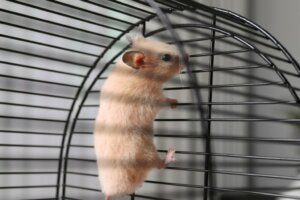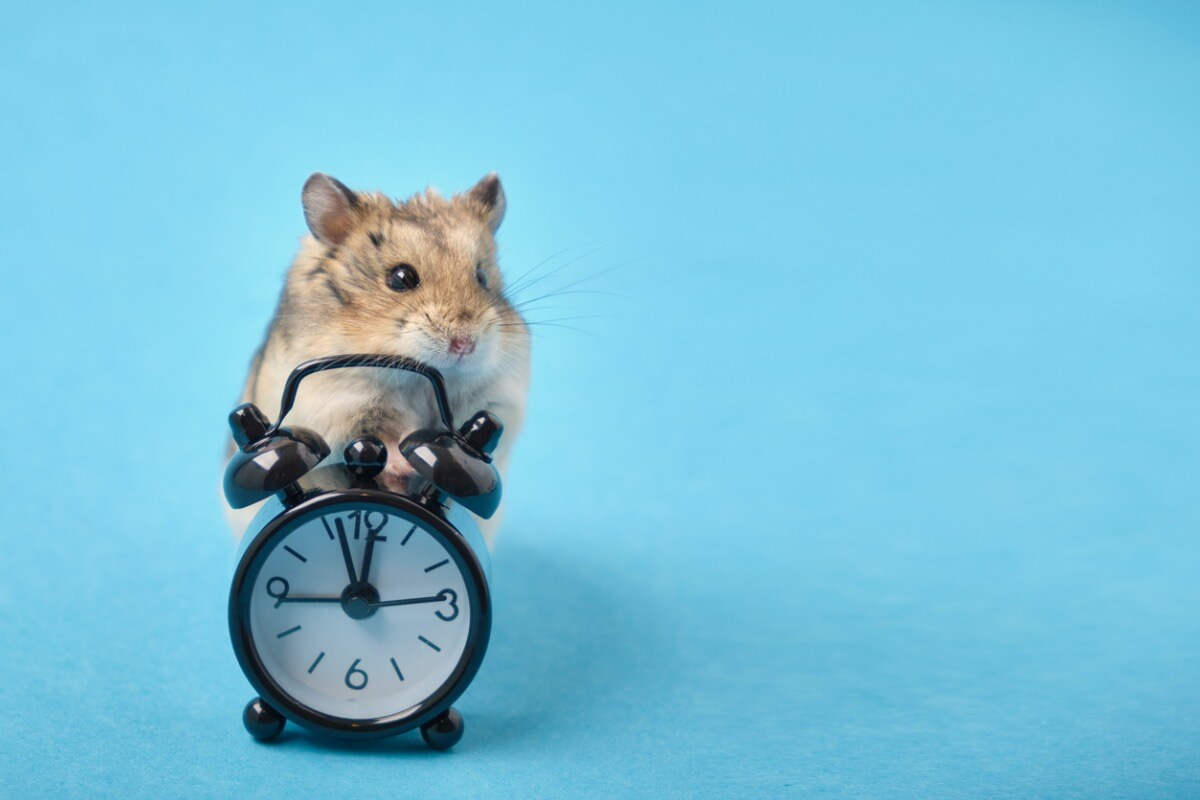Why Does My Hamster Climb Its Cage?

Hamsters are one of the most popular pets in the world, especially among first-time tutors. These rodents are appreciated for their playful, energetic, and inquisitive character. Their pompom-shaped tails, chubby bodies, and black eyes can soften the heart of even the hardest people. However, today we’re going to ask what makes a hamster climb its cage. Is there something wrong? Find out more.
Although owning one of these animals is wonderful, sometimes domestic rodents baffle us with behavior that’s very difficult to decipher. One example here, as we’ve just mentioned is why a hamster will climb up his cage? Keep reading to find out some clues to this behavior!
The behavior of the domestic hamster
The term hamster is used to describe rodent mammals (Rodentia) that belong to the subfamily Cricetinae. This group has 19 different species, which are divided into 7 genera. Some of the most famous ones are the Syrian hamster (Mesocricetus auratus), the Chinese hamster (Cricetulus barabensis), and the Russian hamster (Phodopus sungorus).
Hamsters are typical prey animals. This means that they form part of the diets of reptiles, canids, felids, raptors, and many more vertebrates in the natural environment. For this reason, they’re quite discreet and spend most of the day protected inside their den. They only come out at dusk and nightfall and, according to studies, their most active period is from 6 pm to 6 am.
These rodents rest in their cages (or in their dens in the wild) during the day and sleep an average of 6-8 hours. However, it should be noted that their sleep pattern is polyphasic and they wake up several times between naps. Therefore, it isn’t uncommon to see them lazily foraging for food when it’s still light outside.
Hamsters reach their peak of activity well into the night, when the incidence of light is practically nil. It’s very important to respect their routine.

Why does your hamster climb up its cage?
All hamster species have an extremely fast metabolic rate. This means that they eat a lot (for their weight and size), expend large amounts of energy, grow quickly, reproduce in record time, and die within a few years. A female will live only about 2 years, but she can give birth to more than 30 offspring during her lifetime.
In this article, we want to show how lively and physically active these animals are. This partly explains why your hamster climbs the cage. We’ll dissect their behavior in more detail in the following sections.
1. They need to burn energy
If your hamster adopts his climbing behavior at night from time to time, there’s nothing to worry about. It’s just burning off energy and exercising its muscles, just as it would in the wild running through the bushes. Sit back and enjoy the spectacle: it’s quite a sight to see a rodent clinging to the bars of its cage like a primate does.
2. Not enough environmental enrichment
The term environmental enrichment refers to everything that promotes the physical and emotional well-being of an animal regarding its surroundings and what you provide for it. If your hamster only climbs the cage and does nothing else when it’s moving around, chances are it’s lacking things inside its cage to stimulate it.
To stop this behavior (and prevent it from becoming an obsession or stereotypy) you can add the following options:
- A cage with two floors connected by plastic tubes: Hamsters love tubes and closed spaces, as they have a similar setup to what their burrow would have. They’ll have a lot of fun going through these tunnels.
- Running wheel: The wheel is an essential accessory in any facility for rodents. Without it, they’ll become obese sooner or later.
- Ladders, bead balls, weights, and other wooden toys (always purchased at a pet shop).
- A ball-basket with food inside: Placing part of the animal’s food inside a toy that’s difficult to access will stimulate them a lot and force them to use their instincts.
To prevent your hamster from getting bored, you can change the toys cyclically every month. However, don’t move the hamster’s hutch under any circumstances, as this could stress it out. Just vary the elements that aren’t necessary for its survival (exercise gadgets, tubes, and toys with tidbits for rodents).
3. It’s trying to escape
It’s one thing if your hamster climbs the cage at night, but it’s quite another if it constantly tries to get out the door, tries to bite the bars, or exhibits this behavior also during the day. Unfortunately, this usually indicates that the animal is stressed and needs to run away.
First of all, check to see if any other pets could be making your hamster feel in danger (such as a cat). If not, keep an eye out for sources of loud noise or if the cage is in a place where light is shining directly on it. For example, the rodent may be trying to escape from the facility because the sun is shining and it’s too hot.
In this case, the best thing to do is to move the cage. If the distressing behaviour persists, see your vet.

Is it good to let the hamster climb its cage?
Although it isn’t a bad thing for the hamster to use the bars of its cage for climbing, there are some caveats. For example, it’s strongly discouraged in very high cages, as a fall could damage a bone. If this is your case, we recommend that you put a second floor in the cage, thus taking advantage of its height and giving your rodent more space and variety.
And just a final note: hamsters with tumors and pre-existing injuries require special care. The best thing to do if you have a sick rodent is to place it in a very simple glass installation (always without a lid to maintain ventilation), without toys or accessories. This is the only way to avoid mishaps caused by physical activity in weak animals.
All cited sources were thoroughly reviewed by our team to ensure their quality, reliability, currency, and validity. The bibliography of this article was considered reliable and of academic or scientific accuracy.
- Kaim, I., Hedrzak, M., & Ziewacz, L. (2013). Daily activity pattern of the common hamster (Cricetus cricetus) at two localities situated in urban and rural areas. Zoologica Poloniae, 58(3-4), 59.
- Delville, Y., David, J. T., Taravosh-Lahn, K., & Wommack, J. C. (2003). Stress and the development of agonistic behavior in golden hamsters. Hormones and behavior, 44(3), 263-270.
This text is provided for informational purposes only and does not replace consultation with a professional. If in doubt, consult your specialist.